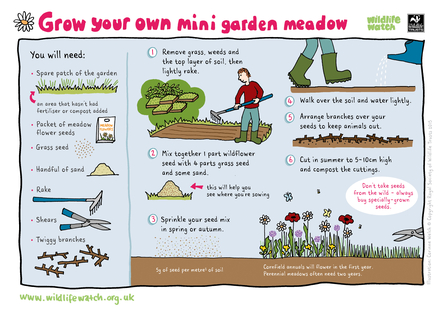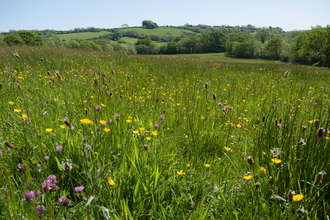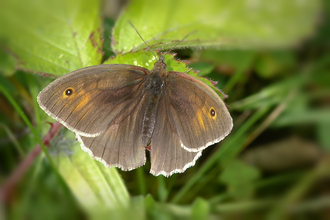
Where to see wildflower meadows
Where to see wildflower meadows
Britain’s meadows hum with life - from the first flowers of spring to misty autumn days when birds flock to berry-laden hedges.
Whether it is a blaze of yellow from meadow buttercups, the whirr of grasshoppers and crickets or the nodding, papery petals of the rare snake’s head fritillary – colours and sound fill the senses. Tragically, nearly all our of wildflower meadows have disappeared as farming practices have changed and towns and villages have expanded to swallow up flower-rich fields. Luckily some farmers and conservation charities work hard to maintain these precious species-rich habitats. The Wildlife Trusts look after hundreds of ancient meadows as nature reserves and often these are the best and last remaining examples in a county. They are usually free to visit and in the summer we ask that people keep to paths at the edges of fields to avoid trampling wildlife. The view is just as good from there!

Clattinger Farm - Barney Wilczak
How does the Meadow flower its bloom unfold? Because the lovely little flower is free down to its root, and in that freedom bold.
Find a wildflower meadow
Here's our list of 50 of the finest wildflower meadows in the UK, cared for by Wildlife Trusts:
North
Cheshire Wildlife Trust
Sean Hawkins Meadow - Small species rich wet meadow by a stream and a small area of woodland
Cumbria Wildlife Trust
Augill Pasture - Around the remains of old lead smelt mills, species rich grasslands contain a huge variety of different meadow flowers such as orchids, melancholy thistle and devil's-bit scabious.
Durham Wildlife Trust
Hannah's Meadow - This upland hay meadow and a grazing pasture are set within the traditional farming landscape of Teesdale, part of the North Pennines Area of Outstanding Natural Beauty.
The Wildlife Trust for Lancashire, Manchester and North Merseyside
Freeman's Pasture - This nature reserve is one of the few species-rich grasslands remaining in Lancashire. Over 120 plant species have been recorded here.
Northumberland Wildlife Trust
South Close Field - This small reserve is one of the best lowland meadows in the area, featuring grassland which is particularly good for spotting butterflies and a small pond attracting amphibians and damselflies.
Sheffield Wildlife Trust
Carr House Meadows - Here fields are hemmed by drystone walls and hedgerows and invertebrates such as butterflies, beetles, spiders and grasshoppers all thrive in the rich foliage.
Yorkshire Wildlife Trust
Ashes Pasture - An idyllic location in Ribblesdale adds to the charm of this diverse grassland nature reserve. In spring and summer, the grassland is dotted with orchids and other flowering plants and buzzing with bumblebees.
Ledsham Bank - A botanist's dream come midsummer, Ledsham Bank is alive with colour from the fantastic displays of wildflowers.
Kiplingcotes Chalk Pit - A wander through Kiplingcotes Chalk Pit in high summer will reveal a riot of colour, with dozens of butterflies fluttering around an explosion of wildflowers in some of the sheltered spots and farmland birds such as yellowhammers singing from the scrub.
Midlands
Birmingham and the Black Country Wildlife Trust
Castle Vale - Work carried out by the Nature Improvement Area team with the help of the local community has created ''magnificent meadows'' from a little-used, poor quality wasteland.
Derbyshire Widlife Trust
Hartington Meadows - Bursting with the colour of wildflowers through summer, this grassland nature reserve is cut for hay in mid-July.
Priestcliffe Lees - Offering extensive views across the Wye Valley in the Peak District, this SSSI designated reserve lies on a limestone hillside above the famous Monsal Trail, a disused railway track, now a cycleway and a great way to explore Priestcliffe Lees.
Rose End Meadows - This reserve is made up of 11 small fields, showing how Derbyshire's limestone farmland would have looked 100 years ago.
Leicestershire & Rutland Wildlife Trust
Cribbs Meadow - The fields lie on Boulder Clay, a heavy 'blue' clay containing much fragmented chalk and limestone
Merry's Meadow - The meadows have maintained the ridge and furrow pattern where cowslip, quaking-grass, greenwinged orchid and adders-tounge grow on the ridges.
Lincolnshire Wildlife Trust
Red Hill - This grassland nature reserve is probably an ancient fragment of Lincolnshire Wold down land, and there is a rich assemblage of chalk plants here and in the quarry. Look out for localised species, such as felwort, yellow-wort, basil thyme, kidney vetch and pyramidal and bee orchids.
Nottinghamshire Wildlife Trust
Ashton's Meadow - Ashton's Meadow is a traditionally maintained ancient meadow that has not seen the use of artificial methods or pesticides for many years. You can still see the original ridges and furrows, while admiring a rich diversity of flowers and wildlife. Spring and summer are the best time to see the array of wild flowers on the reserve, while the grassland butterflies are best seen from July.
Warwickshire Wildlife Trust
Draycote Meadows - These picturesque traditional hay meadows are the 'creme de la creme' of remaining unimproved grassland found in Warwickshire today.
Bubbenhall Meadow - Enjoy the contrast of ancient woodland and new meadow with ponds and pools.
Brook Meadow - An old traditional hay meadow with beautiful wild flowers.
South
Berkshire, Buckinghamshire and Oxfordshire Wildlife Trust (BBOWT)
College Lake - One of the crowning jewels of this reserve is the summer display of cornfield flowers; whole fields come alive with a riot of colour, the song of skylarks and the buzz of insects.
Chimney Meadows - Arable land was purchased as part of an appeal to restore the traditional hay meadows as part of the national Biffa Award funded Coronation Meadows project.
Iffley Meadows - These ancient wet meadows are famous for their annual display of snake's-head fritillaries and are designated as an SSSI.
Cornwall Wildlife Trust
Chyverton - This 10 acre nature reserve in mid-Cornwall close to the A30 consists of flower-rich meadows, ancient Cornish hedgerows and areas of mixed woodland. Because the meadows have been largely unimproved for agricultural purposes, they provide a variety of habitats for a diverse range of wildlife.
Devon Wildlife Trust
Cricklepit Mill - This unusual urban meadow can be found behind Devon Wildlife Trust's office in central Exeter.
Dorset Wildlife Trust
Kingcombe - This nature reserve nestling deep in the Dorset countryside is still managed by traditional farming methods. The result is a patchwork of flower-rich fields and grassland broken up by hedgerows, streams and ponds.
Herefordshire Wildlife Trust
Stockings Meadow - This lovely grassland nature reserve lies on a steep west-facing slope above Hackley Brook. On sunny days you can see bumblebees, butterflies and day-flying moths.
The Sturts - This nature reserve is comprised of seasonally flooded meadow and pasture with a small cider orchard on the drier ground.
The Parks - An impressive sweep of grassland lying on the gentle north and south facing slopes of the Dulas Brook. Flowers such as pignut, common and heath spotted orchid and cuckoo flower can be found here.
Somerset Wildlife Trust
Fivehead Arable Fields - This reserve is home to nationally scarce wildflowers including broad-leaved spurge, spreading hedge-parsley and slender tare.
Surrey Wildlife Trust
Sheepleas - The site is a mosaic of woodlands and grassland that supports a huge diversity of wildlife.
Wiltshire Wildlife Trust
Blakehill Farm - Once a military base this 235 hectare expanse of grassland has a rich variety of wildflowers.
Clattinger Farm - A 170 acre remnant of lowland meadow and one of the finest places to see snake’s head fritillaries in the UK.
East
Bedfordshire, Cambridgeshire & Northamptonshire Wildlife Trust (BCN)
Chettisham Meadow - Cowslips are abundant in this beautiful meadow from March to May with a spectacular display of green-winged orchids in late April to May.
Hertfordshire and Middlesex Wildlife Trust
Hunsdon Mead - During the winter the Mead floods and large flocks of lapwing and golden plover come to feed.
Blagrove Common - The Common is at its best in late spring when carpeted with orchids.
Alpine Meadow - At only 0.8ha this grassland nature reserve is quite small but is rich in wildflowers and butterflies.
Frogmore meadow - This marshy meadow has a range of wetter plants including marsh marigold, greater bird's foot trefoil and ragged robin.
Rye Meads - The seasonal flooding of the meadow combined with the rich soils has resulted in a mosaic of habitats, consisting of reedbeds, marshy grasslands and fen vegetation
Suffolk Wildlife Trust
Fox Fritillary Meadow - The largest of four remaining snake's head fritillary sites in Suffolk this reserve is a wonderful fragment of ancient meadow.
Wales
North Wales Wildlife Trust
Caeau Tan y Bwlch - Swathed in wildflowers in spring and summer and offering lovely views of the coast, this traditional hay meadow offers a glimpse of our countryside’s past.
The Wildlife Trust for South and West Wales
Vicarage Meadows - This 3.6 hectares of wildflower rich meadow and wet pasture is set on the side of a hill in the Irfon valley and lies adjacent to the Nant Irfon National Nature Reserve. Look out for the yellow flower spikes of bog asphodel in the damper parts.
Trewalkin Meadow - This small, damp, flower-rich meadow at the foot of the Black Mountains reveals a glimpse into how much of Brecknock would have looked 60 years ago.
Gwent Wildlfe Trust
New Grove Meadow - The New Grove Meadows reserve provides an unforgettable sight in May and June when thousands of orchid spikes, set against other wildflowers, give a wonderful display of colour. From the reserve there are superb views across fine lowland scenery to the Great Skirrid and Sugar Loaf, which are backed by the full sweep of South Wales’ other mountains.
Pentwyn Farm - Pentwyn Farm has survived virtually unchanged for centuries. It includes one of the largest areas of flower-rich grassland remaining in Gwent and provides an opportunity to see hay meadows as they would have looked in the past, before the advent of intensive farming.
What to look for
Summer is the peak time for wild flower meadows, when whole hillsides are alight with colour and thrumming with insects. While the flowers may be the stars of the show, don't forget the insects; butterflies, like the dark green fritillary, the day-flying burnet moth, bumblebees laden with pollen. If there is water nearby, it’s possible that dragonflies and damselflies will also be zipping through the meadow. Old meadows are sometimes enclosed with hedges consisting of trees and shrubs, including field maple, hazel, hawthorn and spindle, providing a home for even more wildlife.
If you can't get to these places
If you’re not lucky enough to live close to one of these special meadows, it’s still possible to find wildflowers everywhere. Poppies still turn many field margins red, while species such as the beautiful bee orchid, whose flower famously mimics a furry-bodied bee to fool its pollinator, can be found on road verges and open ground around gravel pits. For those really hankering for a splash of summer colour that also benefits wildlife, why not have a go at planting your own wild flower meadow?
Make your own mini meadow

Grow your own mini meadow Illustration: Corinne Welch © Copyright Royal Society of Wildlife Trusts 2015


